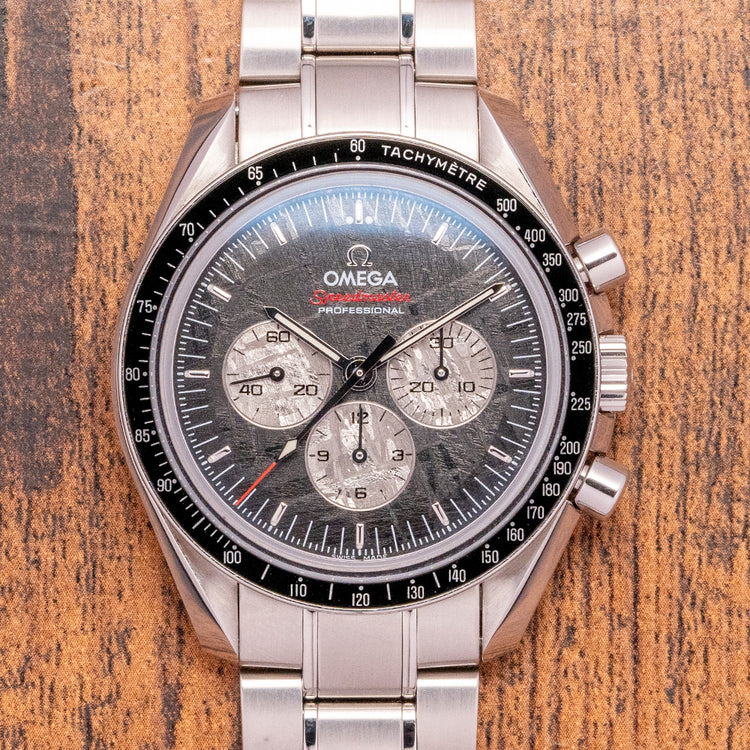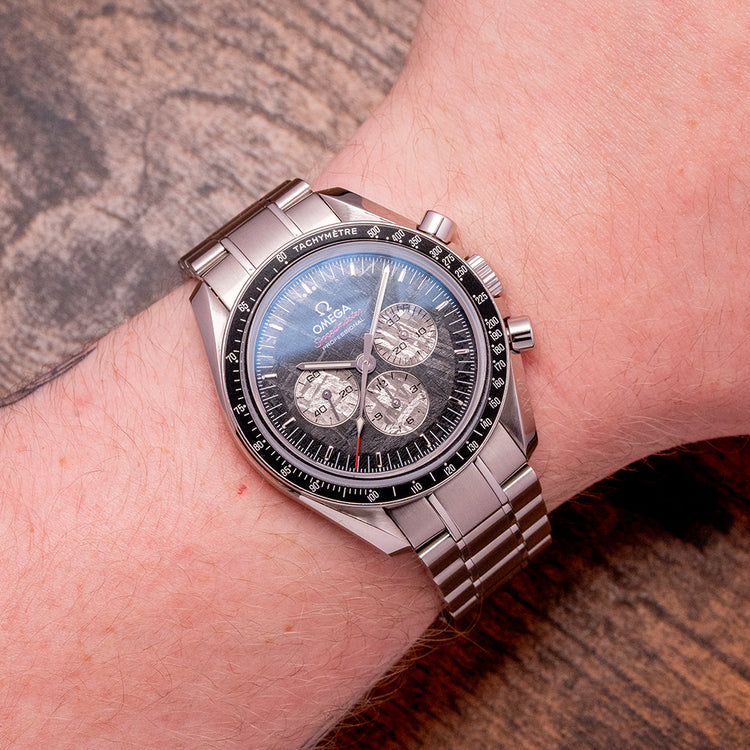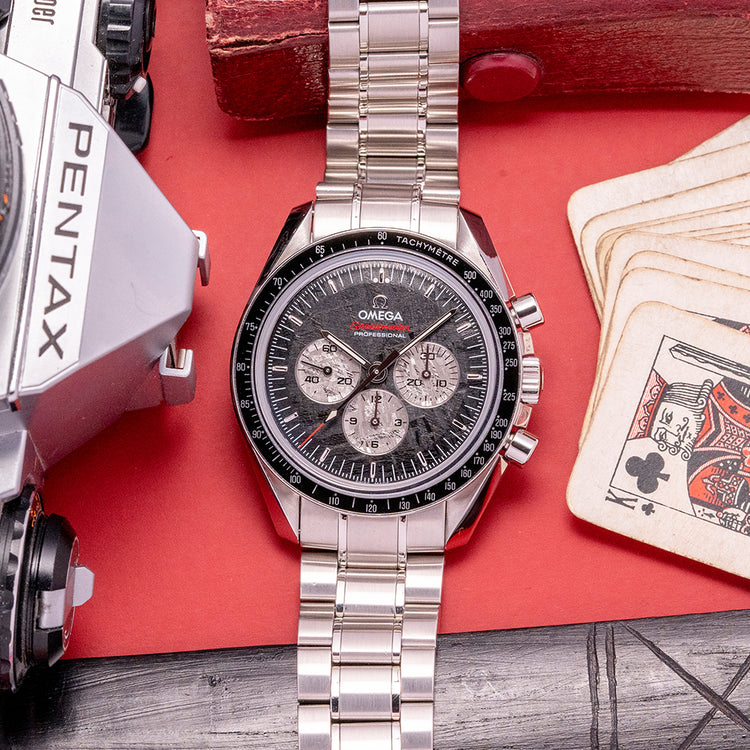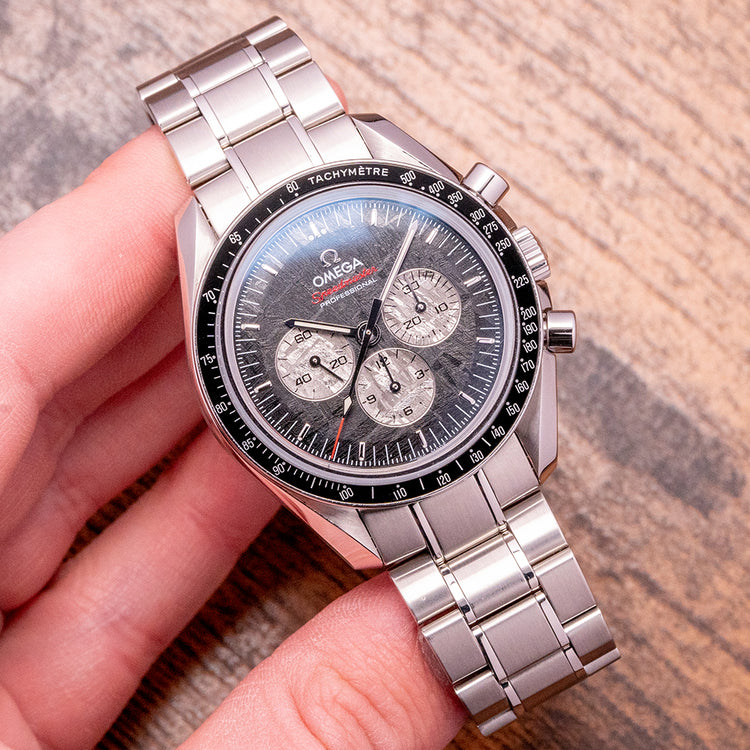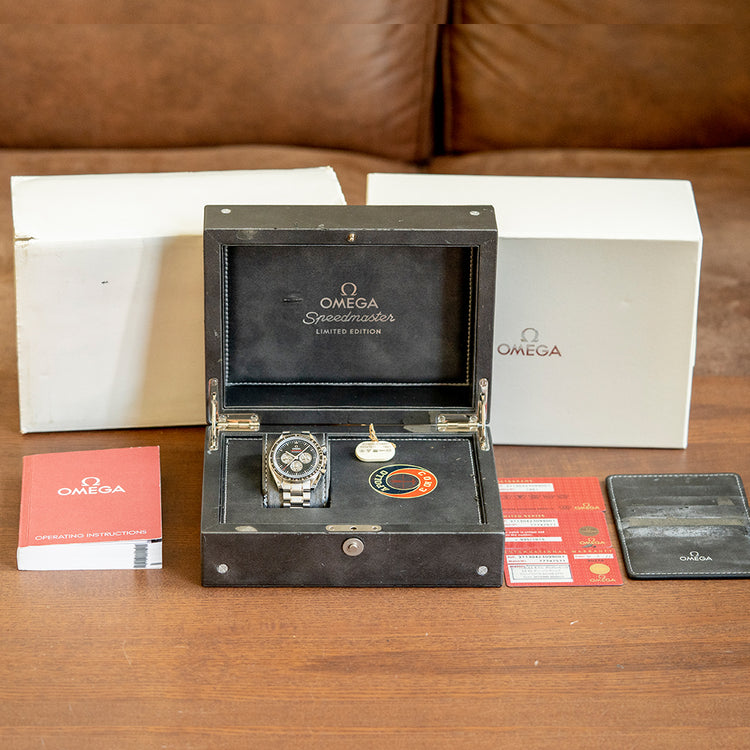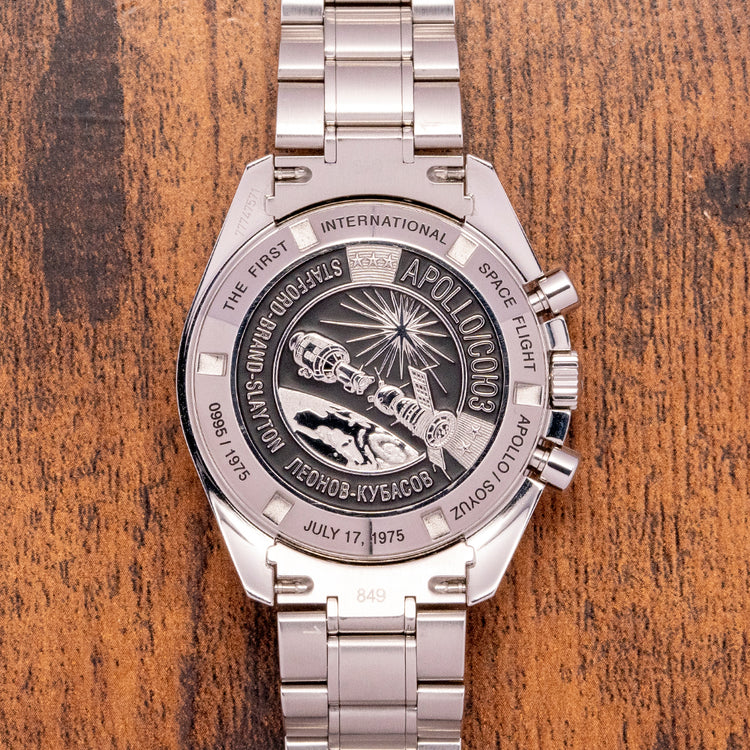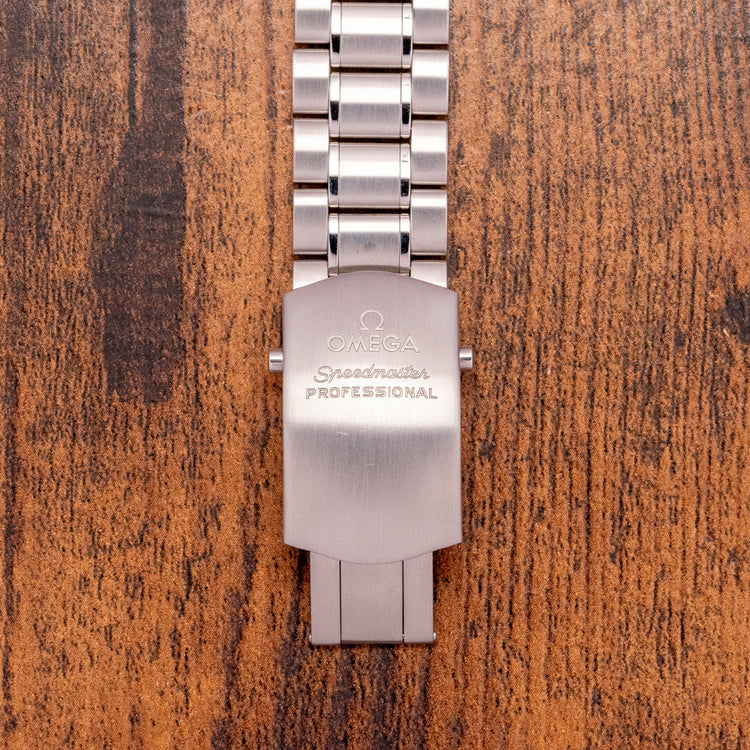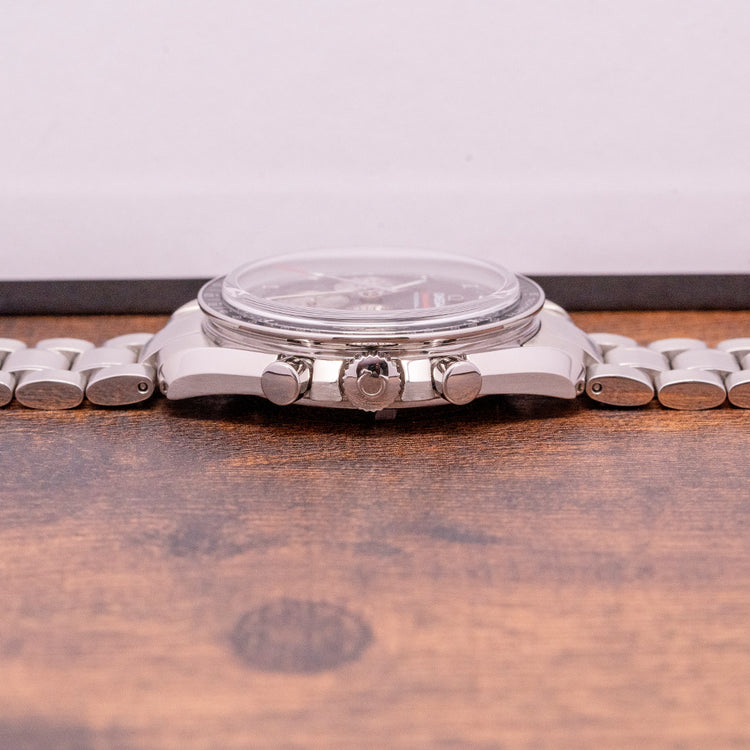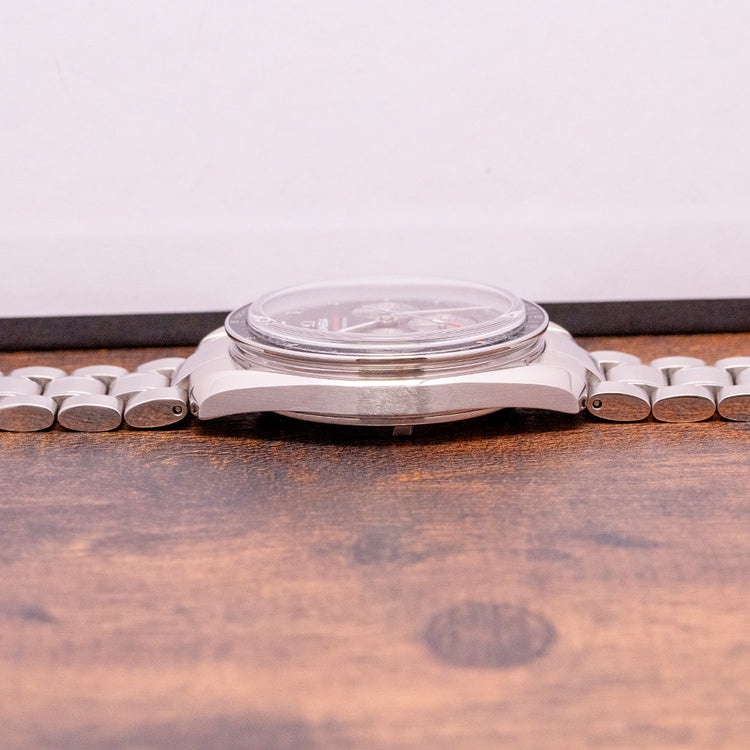More Information
Description
More
Less
The Watch
Here we have a 2011 Omega Speedmaster Apollo Soyuz Meteorite Limited Edition of 0995/1975, this was for the 35th Anniversary of the Apollo-Soyuz mission, which is called the Apollo-Soyuz Test Project (ASTP). This famous Cold War meeting ran from July 15th until July 24th, 1975, on July 17th, the two superpower spacecraft joined 222 kilometres away from Earth, and General Stafford and Colonel Leonov symbolically shook hands. The 42mm stainless steel case has polished and brushed surfaces that lead to the characteristic twisted lugs, the crisp lines transition effortlessly around the case, and the lug-to-lug length of 48mm and a case thickness of 13.5mm ensure a comfortable fit on the wrist. Along the right side, we have the recessed chronograph pushers and a signed crown in the centre. A fixed silver tachymeter sits on its black Aluminium bezel insert surrounding a domed sapphire crystal. The incredible dial is made from an estimated four billion-year-old meteorite that was found in Namibia, Africa, in the 1970s; an outer minute track is precisely executed with baton indexes tipped with lume marking the hours, at 3 o’clock a 30-minute register, at 6 o’clock a 12-hour register and finally at 9 o’clock a small seconds register, slender baton hands are complemented by an arrow point red tipped chronograph hand, at 12 o’clock we have the applied Omega motif, a red “Speedmaster” and “Professional” printed underneath completing this historical commemorative timepiece. On the reverse is a screw-down case back with “First International Space Flight Apollo-Soyuz July 17th 1975” engraved around its edge and an embossed depiction of that famous space flight and the names of the Astronauts and Cosmonauts, inside a manually wound Omega Cal. 1861, 18 jewels hand-wound chronograph beating at 21,600 BPH, as a manual wound movement, it is the direct descendant of the original moon watch that used the Cal. 361 movement. The watch comes paired with its Omega 20mm Stainless Steel bracelet with a signed push button release folding deployant clasp and also comes with its original Omega Limited Edition presentation box and papers.
Points of Mention
This watch is sold with its original Omega Limited Edition box and Omega paperwork. The watch comes paired with its original Omega 20mm bracelet with a signed Omega deployant clasp. The watch is from May 2011 and is sold in worn condition, but overall, it is in excellent condition, as you can see. The watch comes with our 12-Months NON-Waterproof Warranty.
For more photos see here - https://drive.google.com/drive/folders/12bJrkYB6wsCfuL3-Skr94Fiux1JIX2id?usp=drive_link
4K YouTube video, skip to 5:11 - https://youtu.be/jLLegPMeQrE
Personal Note
This Omega Speedmaster Apollo Soyuz Limited Edition features an incredible dial made from an estimated four billion-year-old meteorite that was found in Namibia, Africa, in the 1970s! Not only are you wearing a historically important watch when wearing this, but you also have some incredible history on the dial in the form of a meteorite that is so beautiful to look at and evolves depending on the light. What an incredible gem this reference is, I would not hesitate to book an appointment to see it in the metal or just add it to your collection today!
Specification
Lugs : 20mm
Condition : Pre-Owned
Box & Papers : Box & Papers
Case Material : Stainless Steel
Warranty : 12-Months NON-Waterproof Warranty
The Brand
They were formerly known as the La Generale Watch Co., founded in 1848 by Louis Brandt in La Chaux-de-Fonds. When he died in 1879, his sons carried on his dream. In 1880, they moved to 96 Rue Jakob-Stampfli, where they remain today. The brothers produced their first mass-produced calibre, the Labrador In 1885. Just a few years later, in 1892, they produced the first minute-repeater. In 1903, they renamed the company Omega until 1982, when they officially changed their name to Omega SA. During WW1, Omega watches were used as official timekeepers for the Royal Flying Corps and the US Army. In 1930, Omega and Tissot merged together to form Société Suisse pour l'Industrie Horlogère (SSIH). In 1931, another group was formed - Allgemeine Schweizerische Uhrenindustrie AG (ASUAG). Where SSIH was primarily French-speaking, ASUAG was founded by the more German-speaking members of the Swiss watch industry. In 1948, they introduced the first edition of one of its most symbolic watches: the Seamaster. Omega first introduced the Constellation in 1952. At the time, it was Omega's flagship timepiece. The first models had a Cal. 354 bumper movement in them. Later, in 1955, Omega introduced the Automatic Cal. 50x, followed in 1959 by the Cal.55x (no date) and 56x (date) versions. Many of the Constellations came with pie-pan dials, diamond indexes, and fancy lug configurations. All the gold Constellations of that time have the Observatory of Geneva's hand engraved on the back. The stainless steel and stainless steel/gold versions had a gold medallion on the back with the Observatory of Geneva. The eight stars above the Observatory stand for the many exploits of Omega in the world Chronometer competition. Celebrating the fact that all Constellations are Chronometer Certified. In 1962, when astronaut Wally Schirra wore a Speedmaster on his Mercury Sigma 7 Mission, making it the first Omega watch to enter space. After rigorous tests, NASA used Omega for all their Apollo missions, including the 1969 Moon landing of Apollo 11. Today, Omega is still the first choice of astronauts. In 1969, President Nixon famously said it was “too valuable” and turned down the first-ever all-gold Speedmaster Professional Deluxe. As a response to the ever-growing threat of electronic watches to the manufacturers of mechanical watches, Omega and many Swiss brands such as Rolex and Patek Philippe formed Centre Electronique Horologer (CEH). Prototypes began to appear in 1967, and their production started in 1968. Then, In 1972, Omega introduced the reference 198.030, which included the Omega calibre 1250, a ‘tuning-fork electronic movement which was made under licence from Bulova. Later we saw a merger of SSIH and ASUAG into SMH, or Société de Microélectronique et d’Horlogerie. This merger took place in 1983. In 1992, the company acquired Blancpain, and in 1998, it officially rebranded itself from SMH to the Swatch Group. Then, in 1999, they purchased and integrated Breguet into the Swatch Group.
Points of Mention
More
Less
Personal Note
More
Less
Specification
More
Less
Movement : Manually Wound Omega Cal. 1861
Age : May 2011
Year : 2011
Case Size : 42mm
Case Thickness : 13.5mm
Lug to Lug : 48mm
Lugs : 20mm
Condition : Pre-Owned
Case Material : Stainless Steel
Warranty : 12-Months NON-Waterproof Warranty
The wrist model's wrist size is 7inch
About Omega
More
Less
Description
The Watch
Here we have a 2011 Omega Speedmaster Apollo Soyuz Meteorite Limited Edition of 0995/1975, this was for the 35th Anniversary of the Apollo-Soyuz mission, which is called the Apollo-Soyuz Test Project (ASTP). This famous Cold War meeting ran from July 15th until July 24th, 1975, on July 17th, the two superpower spacecraft joined 222 kilometres away from Earth, and General Stafford and Colonel Leonov symbolically shook hands. The 42mm stainless steel case has polished and brushed surfaces that lead to the characteristic twisted lugs, the crisp lines transition effortlessly around the case, and the lug-to-lug length of 48mm and a case thickness of 13.5mm ensure a comfortable fit on the wrist. Along the right side, we have the recessed chronograph pushers and a signed crown in the centre. A fixed silver tachymeter sits on its black Aluminium bezel insert surrounding a domed sapphire crystal. The incredible dial is made from an estimated four billion-year-old meteorite that was found in Namibia, Africa, in the 1970s; an outer minute track is precisely executed with baton indexes tipped with lume marking the hours, at 3 o’clock a 30-minute register, at 6 o’clock a 12-hour register and finally at 9 o’clock a small seconds register, slender baton hands are complemented by an arrow point red tipped chronograph hand, at 12 o’clock we have the applied Omega motif, a red “Speedmaster” and “Professional” printed underneath completing this historical commemorative timepiece. On the reverse is a screw-down case back with “First International Space Flight Apollo-Soyuz July 17th 1975” engraved around its edge and an embossed depiction of that famous space flight and the names of the Astronauts and Cosmonauts, inside a manually wound Omega Cal. 1861, 18 jewels hand-wound chronograph beating at 21,600 BPH, as a manual wound movement, it is the direct descendant of the original moon watch that used the Cal. 361 movement. The watch comes paired with its Omega 20mm Stainless Steel bracelet with a signed push button release folding deployant clasp and also comes with its original Omega Limited Edition presentation box and papers.
Points of Mention
This watch is sold with its original Omega Limited Edition box and Omega paperwork. The watch comes paired with its original Omega 20mm bracelet with a signed Omega deployant clasp. The watch is from May 2011 and is sold in worn condition, but overall, it is in excellent condition, as you can see. The watch comes with our 12-Months NON-Waterproof Warranty.
For more photos see here - https://drive.google.com/drive/folders/12bJrkYB6wsCfuL3-Skr94Fiux1JIX2id?usp=drive_link
4K YouTube video, skip to 5:11 - https://youtu.be/jLLegPMeQrE
Personal Note
This Omega Speedmaster Apollo Soyuz Limited Edition features an incredible dial made from an estimated four billion-year-old meteorite that was found in Namibia, Africa, in the 1970s! Not only are you wearing a historically important watch when wearing this, but you also have some incredible history on the dial in the form of a meteorite that is so beautiful to look at and evolves depending on the light. What an incredible gem this reference is, I would not hesitate to book an appointment to see it in the metal or just add it to your collection today!
Specification
Lugs : 20mm
Condition : Pre-Owned
Box & Papers : Box & Papers
Case Material : Stainless Steel
Warranty : 12-Months NON-Waterproof Warranty
The Brand
They were formerly known as the La Generale Watch Co., founded in 1848 by Louis Brandt in La Chaux-de-Fonds. When he died in 1879, his sons carried on his dream. In 1880, they moved to 96 Rue Jakob-Stampfli, where they remain today. The brothers produced their first mass-produced calibre, the Labrador In 1885. Just a few years later, in 1892, they produced the first minute-repeater. In 1903, they renamed the company Omega until 1982, when they officially changed their name to Omega SA. During WW1, Omega watches were used as official timekeepers for the Royal Flying Corps and the US Army. In 1930, Omega and Tissot merged together to form Société Suisse pour l'Industrie Horlogère (SSIH). In 1931, another group was formed - Allgemeine Schweizerische Uhrenindustrie AG (ASUAG). Where SSIH was primarily French-speaking, ASUAG was founded by the more German-speaking members of the Swiss watch industry. In 1948, they introduced the first edition of one of its most symbolic watches: the Seamaster. Omega first introduced the Constellation in 1952. At the time, it was Omega's flagship timepiece. The first models had a Cal. 354 bumper movement in them. Later, in 1955, Omega introduced the Automatic Cal. 50x, followed in 1959 by the Cal.55x (no date) and 56x (date) versions. Many of the Constellations came with pie-pan dials, diamond indexes, and fancy lug configurations. All the gold Constellations of that time have the Observatory of Geneva's hand engraved on the back. The stainless steel and stainless steel/gold versions had a gold medallion on the back with the Observatory of Geneva. The eight stars above the Observatory stand for the many exploits of Omega in the world Chronometer competition. Celebrating the fact that all Constellations are Chronometer Certified. In 1962, when astronaut Wally Schirra wore a Speedmaster on his Mercury Sigma 7 Mission, making it the first Omega watch to enter space. After rigorous tests, NASA used Omega for all their Apollo missions, including the 1969 Moon landing of Apollo 11. Today, Omega is still the first choice of astronauts. In 1969, President Nixon famously said it was “too valuable” and turned down the first-ever all-gold Speedmaster Professional Deluxe. As a response to the ever-growing threat of electronic watches to the manufacturers of mechanical watches, Omega and many Swiss brands such as Rolex and Patek Philippe formed Centre Electronique Horologer (CEH). Prototypes began to appear in 1967, and their production started in 1968. Then, In 1972, Omega introduced the reference 198.030, which included the Omega calibre 1250, a ‘tuning-fork electronic movement which was made under licence from Bulova. Later we saw a merger of SSIH and ASUAG into SMH, or Société de Microélectronique et d’Horlogerie. This merger took place in 1983. In 1992, the company acquired Blancpain, and in 1998, it officially rebranded itself from SMH to the Swatch Group. Then, in 1999, they purchased and integrated Breguet into the Swatch Group.
Points of Mention
Personal Note
Specification
The Brand
Enquire or Book an Appointment
Would you like to discover further details about this watch, or perhaps arrange an appointment to view and try it on? Complete this form and a member of our team will get back to you shortly.
You May Also Like




















